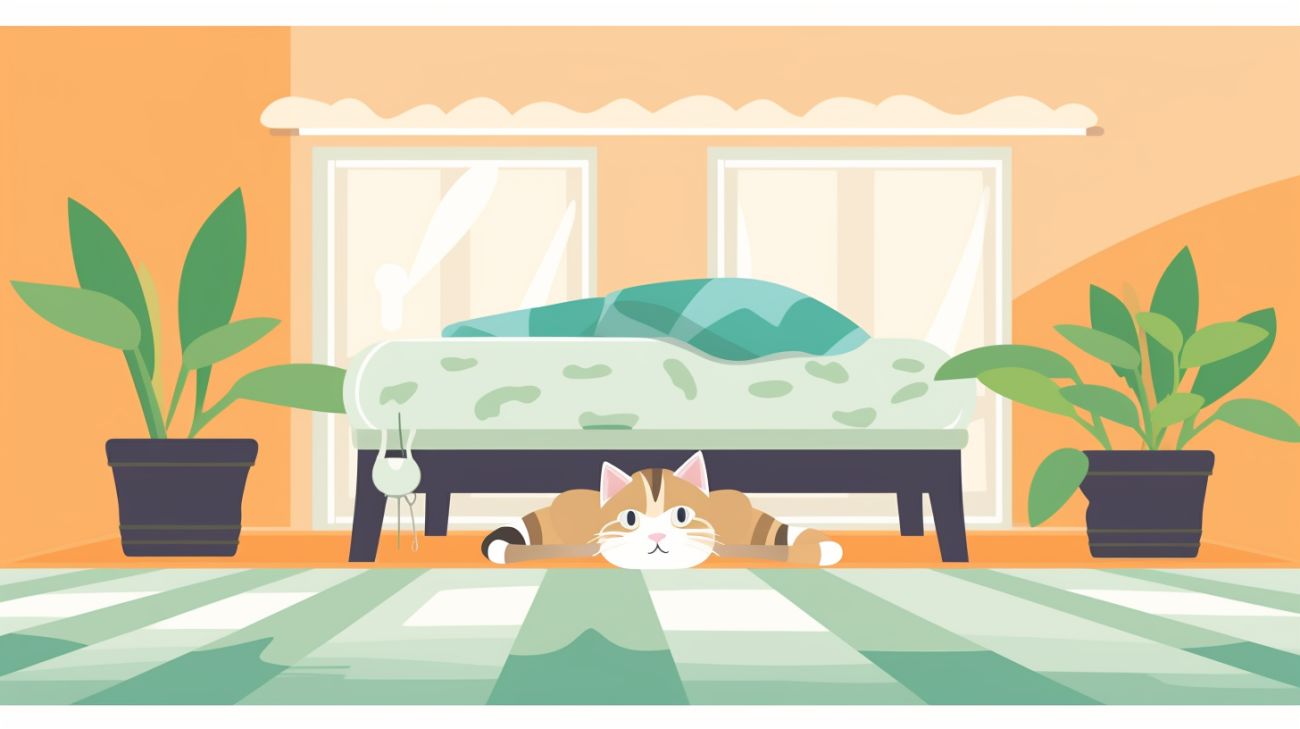Key takeaways
If you're reading this, chances are you're concerned about your cat's hiding behavior. It can be stressful when our beloved pets seem to vanish into thin air, leaving us wondering how to get our cat out of hiding.
First, take a deep breath and remember that this is a common issue many cat owners face. We're here to guide you through the process and offer helpful tips to bring your fur baby back into the open.
We're going to explore why your cat may be hiding, techniques to lure them out, and ways to help destress them.
Quick Navigation
Understanding cat hiding behavior
New environments or changes in the household
Sudden loud noises (e.g., thunderstorms, fireworks)
Introduction of a new cat, other pets, or people
Illness or pain
Cats are naturally inclined to hide as a survival instinct. This behavior can be triggered by new environments, loud noises, introduction of new pets or people, and illness or pain.

How to recognize signs of hiding
1.
Under beds, sofas, or other furniture
2.
Inside closets or cupboards
3.
Behind appliances (e.g., washing machines, refrigerators)
4.
In boxes or bags
5.
High shelves or rafters

Preparing to approach your hiding cat
Tip 1: Remove any potential stressors from the room, such as loud noises or unfamiliar objects.
Tip 2: Speak softly and use a soothing tone of voice to help calm your cat.
Tip 3: Avoid making sudden movements or standing directly over your cat, as this can be intimidating.
Tip 4: If possible, sit or lie down on the floor to appear less threatening.
Tip 5: Give your cat space and time to get used to your presence before attempting to interact with them.

Techniques to lure your cat out of hiding
Using food and treats
Canned tuna or salmon: The strong smell of these fish can be irresistible to cats.
Boiled chicken: Unseasoned and shredded, it can entice your cat to investigate and eat.
Commercial cat treats: Choose their favorite flavor, and shake the bag to make that irresistible sound.
Catnip: For some cats, the smell of catnip can be more tempting than food.

Utilizing toys and playtime
Interactive toys can be a fun and engaging way to lure your cat out of hiding. Stimulating their natural hunting instincts can entice them to leave their safe spot for playtime.

The power of scent
Your clothing: A worn shirt or a pair of socks can provide your cat with the comforting smell of their favorite person.
Blankets: A blanket your cat likes to sleep on can serve as a familiar scent to lure them out.
Pheromone spray: Products like Feliway mimic the natural facial pheromones of cats, helping to create a calming environment.
Pet beds: If your cat has a favorite bed, place it near their hiding spot to encourage them to come out.
Catnip: As mentioned earlier, the scent of catnip can have a powerful effect on some cats, drawing them out of hiding.

Familiar scents can offer comfort and reassurance to your hiding cat. Using personal items or pheromone products can help create a sense of security, enticing your cat to emerge from their hiding spot.
Using Positive Reinforcement
Praise: Speak gently and use a soothing tone when your cat comes out of hiding.
Treats: Reward your cat with their favorite treat for emerging from their hiding spot.
Petting: Offer gentle strokes and scratches in their preferred spots, such as behind the ears or under the chin.
Playtime: Engage your cat with a favorite toy to reinforce their decision to come out.
Cuddle time: Offer your cat the opportunity to snuggle with you, reinforcing the bond between you two.

Dealing with specific hiding triggers
Hiding during storms or fireworks
1.
Create a safe space: Set up a cozy, quiet area in your home where your cat can feel secure.
2.
Close windows and doors: Minimize the noise by keeping windows and doors shut.
3.
Use white noise or calming music: Drown out the sounds with soothing background noise.
4.
Stay close to your cat: Your presence can provide comfort and reassurance during these times.
5.
Use calming products: Pheromone diffusers or sprays can help create a relaxing atmosphere.
Create a safe space, minimize the noise, use calming sounds, and stay close to your cat during storms or fireworks.

Managing cat anxiety
Maintain a consistent routine: Predictability can help alleviate anxiety in cats.
Create a calm environment: Reduce loud noises and chaos in your home to help your cat feel more at ease.
Offer safe spaces: Provide hiding spots and perches where your cat can feel secure.
Socialize your cat gradually: Slowly introduce your cat to new people or pets to avoid overwhelming them.
Recognize and manage your cat's anxiety to address their hiding behavior effectively.

FAQs
How do you lure a cat out of hiding?
To lure a cat out of hiding, tap into their powerful sense of smell. Leave strong-smelling food and treats outside their hiding place and leave them alone.
Will a cat eventually come out of hiding?
A cat will most likely eventually come out of hiding. However, if they have been hiding for more than 24 hours, you should intervene to ensure they are getting enough food and water.
How do I get my cat to stop hiding?
To get your cat to stop hiding, you should make sure they feel comfortable and safe in their environment. Avoid having guests over and keep noise levels down, a scared cat is more likely to continue hiding.
Should I drag my cat out of hiding?
No, you should never drag your cat out of hiding. This will frighten and stress them, making them hide for longer.
Why is my cat hiding?
Your cat may be hiding for a variety of reasons, including fear, stress, anxiety, injury, and illness.
What does it mean when a cat hides and doesn't eat?
If your cat is hiding and not eating, this may indicate that they are sick, injured, or in some kind of pain. It may also indicate high stress levels, anxiety, and fear.



